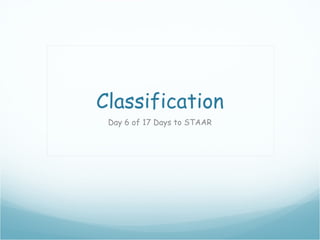
Day6 classification
- 1. Classification Day 6 of 17 Days to STAAR
- 2. How scientists classify living organisms: Prokaryotic- lack a nucleus and membrane (ex: bacteria) Eukaryotic- have a nucleus and a membrane that encloses complex structures, such as the nucleus (ex: plant cell)
- 3. How scientists classify living organisms: Unicellular- made up of only one cell (ex: paramecium) Multicellular- made up more than one cell (ex: humans)
- 4. How scientists classify living organisms: Autotroph: make their own food using radiant energy from the sun into glucose (sugar) (ex: tree) Heterotroph: eats other organisms to survive (ex: cow)
- 5. How scientists classify living organisms: Asexual reproduction: offspring arise from a single parent, resulting in uniform offspring (ex: bacteria) Sexual reproduction: offspring arise from the mating of 2 parents; produces genetically diverse offspring (ex: dog)
- 6. Reproduction: Reproduction is a characteristic of all living organisms. Inherited traits are governed in the genetic material found in genes on chromosomes within the nucleus of the cell.
- 7. Classification Scientists classify organisms based on certain characteristics. They are classified into the following: Domain Kingdom Phylum Class Order Genus Species
- 8. Domains & Kingdoms The 3 Domains: Archaea- a prokaryote that may survive in extreme environments Bacteria- a prokaryote that cannot survive in extreme environments Eukarya- any eukaryote The 6 Kingdoms: Archaea (Domain Archaea) Bacteria (Domain Bacteria) Prostista (Domain Eukarya) Plantae (Domain Eukarya) Fungi (Domain Eukarya) Animalia (Domain Eukarya)
- 9. Dichotomous Keys: Scientists classify living and nonliving things using a tool called a dichotomous key. A dichotomous key is a system used to identify plants, animals, rocks, or minerals made up of a series of paired descriptions to choose between. Dichotomous keys are used for identification of organisms, such as birds, trees, insects, vertebrates, invertebrates, and flowering plants.